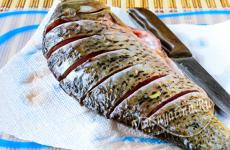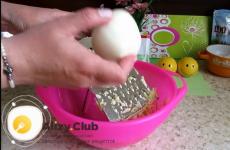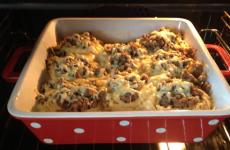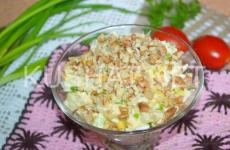Liquid waterproofing deep penetration. Overview of penetrating waterproofing. Benefits of penetrating waterproofing
Waterproofing is one of the best ways to protect foundations from the harmful effects of groundwater. Moisture is capable of destroying not only classic brick or rubble masonry, due to its chemical properties, water also destroys durable concrete over time, destroys the reinforcing cage of the base. It is necessary to select waterproofing taking into account the peculiarities of the climate of the region and the type of foundation.
The main types of foundation waterproofing
Three main types of coatings can protect the foundation from moisture:
- Coating. These are special waterproof coatings that create a waterproofing layer no more than 3 mm thick. They are made from bitumen (solid or resinous product) with the addition of polymer resins and essential oils, rigid and elastic polymer-cement compositions. The main purpose is to prevent capillary penetration of moisture into the concrete structure, applied with a spatula or roller. In some cases, when the coating waterproofing is supplied in the form of a suspension, it is applied by spraying.
- Foundation waterproofing is a built-up layer. This group of products includes roofing felt, various kinds of penetrating membranes and bitumen polymers. The peculiarity is that they are all made on the basis of bitumen, therefore, for better pasting, the materials need to be heated. For the price, the waterproofing of the foundation is cheap, its disadvantage is a possible violation of tightness and the penetration of moisture through the joints.
- Penetrating waterproofing, its second name is plaster. These are materials that are produced on the basis of cement with the addition of various composite compositions and are applied to the surface in the form of a solution. In most cases, these are powders. They are sold in bags, before use they must be diluted in water and applied with a spatula like ordinary gypsum. The average thickness of the coating is 5-15 mm, it copes well with capillary moisture, but is not very resistant to mechanical damage, and cracks appear on the coating over time.
The choice of this type of waterproofing is quite large, almost all of them are made on a mineral basis, therefore they are environmentally friendly.
Penetrating waterproofing - principle of operation

Concrete is a porous material, inside of which there are specific micro-channels through which moisture can penetrate inside. It is possible to close such micro-channels only by external high-quality processing. Moisture, getting into the middle of the concrete foundation, after freezing, expands to significant volumes and destroys the concrete from the inside. It gradually destroys the internal structure of concrete and slowly gets to the reinforcing cage. If metal corrosion begins, it is almost impossible to stop it, and in a few years the destruction of the foundation will begin.
Fused waterproofing is not suitable for all types of foundations. It is often used as an outer protective layer for other insulations.
Modern types of gluing or coating materials are not resistant to mechanical stress and cover only the outer surface of the foundation, practically without penetrating into the pores.
Penetrating waterproofing, in turn, due to the formed crystals of water-insoluble mineral salts, gets inside the pores and clogs them, protecting the integrity of the concrete. Crystals are able to fill even minimal porous channels, and water infiltration no longer occurs due to the increased surface tension of the water surface. That is why the choice of penetrating waterproofing is justified.
Penetrating waterproofing is a mineral mixture based on cement with the addition of synthetic polymeric materials and resins. They are applied to a cold, damp surface, the crystals will grow almost continuously, so even after mechanical damage to the coating, the waterproofing will quickly recover. This type of protective coating copes well with seasonal temperature changes. Note that this is an environmentally friendly material that can be used both outside and inside the premises. Some slurries can be applied by spraying, but they are expensive and are used more when treating large concrete surfaces.
Types and purpose of the protective layer of the base

According to its composition and purpose, penetrating waterproofing of the foundation is divided into types:
- An aqueous solution that is applied with a brush or spray gun. It is used mainly on new surfaces that do not have visible damage and large cracks.
- Dry mix, it must first be diluted with water to a paste consistency. It is applied with a spatula, used for repair and restoration waterproofing works, it can also be used as a primary layer before installing roofing material.
- Seam waterproofing. This cement mixture is used exclusively for tightening joints and cracks.
In the market of waterproofing materials, liquid mixtures are considered the best, they perfectly cover the porous surface of the concrete base and penetrate to a depth of half a meter. Liquid penetrating waterproofing of the foundation is resistant to atmospheric and mechanical influences, it does not dissolve in acids, alkalis and it is almost impossible to destroy it. After processing a wet surface, a strong crystallization layer is formed, which tends to recover.
Application is carried out in four stages:
- The surface of the foundation must first be cleaned of dust, grease and old bitumen. Then treat the concrete under pressure with water so that it penetrates into the depths of the pores. Clean the protruding parts of the reinforcement from rust and treat with anti-corrosion compounds.
- Mix the composition with water until a suspension of medium density is reached.
- Apply the composition in two layers on the concrete surface, the interval between applications should be at least 6 hours.
- Before applying the second layer, it is recommended to clean the first with a brush to ensure the penetration of the next layer of waterproofing.
If it is necessary to restore the waterproofing layer of the destroyed foundation with a liquid composition, then the mixture is diluted to a thick paste-like mass and applied with a spatula. It is possible to apply decorative coatings over waterproofing only after a month.
Foundation repair with penetrating waterproofing

The essence of the method lies in the fact that some special mixtures tend to quickly harden under the influence of water, forming a solid concrete plug in places where the base is deformed:
- A crack or seam must first be expanded, deepened and cleaned of dust and foreign objects.
- Then prepare a thick paste, mold it into a plug in the form of a hole in the concrete. All work must be carried out as quickly as possible, since the mixture dries quickly enough.
- Install the plug in the gully, clamp it with your hands or improvised heavy materials for a few minutes. This time will be enough to start active crystallization, the mixture can heat up significantly during this time.
The surface of the ravine is leveled with a composition and treated with a liquid penetrating waterproofing.
Advantages and disadvantages

This is the best tool to protect the foundation from moisture in porous micro-channels:
- It is possible to form a deep waterproofing layer.
- It is one of the few waterproofing materials that can be successfully applied to the treatment of indoor living spaces, since the waterproofing does not form volatile substances hazardous to health.
- Can be applied to wet surfaces regardless of the direction of groundwater flow.
The disadvantages include:
- Provides protection of porous micro-channels from moisture only in concrete structures, not suitable for processing brick and rubble foundations.
- Penetrating waterproofing can only be used on crack-resistant concrete foundations.
- Cannot be used for waterproofing structures made of porous materials.
- Cannot be applied to prefabricated strip foundations due to the presence of too large joints between the blocks.
In addition to dry mixes, which are then diluted with water, for greater efficiency, it is also desirable to use pasted waterproofing. Then both layers of material will provide maximum reliability and protection against moisture. Some types of waterproofing are also added to the concrete before it is prepared and poured. This results in a material that is resistant to moisture, mechanically strong and inert to contaminated water. When applying penetrating waterproofing, you must remember the safety rules, work with rubber gloves and goggles.
During construction, experts advise paying special attention to protection against moisture. For this, various mastics, bikrost are used. However, the builder does not always have enough experience to do everything right, which leads to the appearance first in, and then in residential premises. Not only is this moment very unpleasant and harmful to the health of those living in the house, moisture also destroys buildings. In this case, you can use this type of protection against water, such as penetrating for concrete. It can be used when the dwelling is already built, applying the compound from inside the basement walls.
A similar layer is applied from the inside of the room (most often in) to the walls and floor - they are most susceptible to getting wet. If instead of such material the same bikrost is used, there will be no sense in the work - they will be useless. After a short time, the coating will swell, water will collect between it and the wall, which will even worse affect the state of concrete strength.
Penetrating compounds act differently. Soaking into concrete, like a sponge, they fill the smallest channels that are always present in. Further, meeting with water, the composition crystallizes, tightly clogging the channel and blocking the path of water. Thus, maximum protection against moisture penetration through the basement walls is provided.

Important information! Such compositions will be useless when applied to porous materials such as foam block. In this case, it is necessary to protect the structure from the outside as much as possible even at the construction stage.
Penetrating waterproofing for concrete: general performance and technical characteristics
Such a material may be coated or have a liquid consistency. Depending on this, the method of application is selected. Before starting work, you should understand what features each of these types has.

Liquid penetrating waterproofing for concrete and its features
Such material is sold in finished form. By consistency, it can be compared with PVA glue. The composition is applied quite simply - for this they use brushes, rollers or even sprayers, but there is one caveat: it is rather difficult to distribute such material evenly over the entire surface. In addition, the applied layer requires a separate protection.

Coating penetrating waterproofing and its advantages over liquid
The action of the coating mixture is similar to liquid impregnation, however, it does not penetrate so deeply. But if all the work was done correctly, the protection against water will be maximum. The advantage of such a composition is its high adhesion and elasticity, which allows protection from moisture penetration and subsequently, when new cracks appear in. If you talk about which penetrating waterproofing is better, then the use of coating insulating material would be a better choice.

Pros and cons of using such insulating materials
Like any other material, penetrating waterproofing for concrete has both positive and negative qualities. Now let's try to understand them. For the convenience of the reader, consider the qualities of the composition in tabular form.
| Advantages | disadvantages |
| The composition can be applied from the inside, moreover, even on a damp surface, which allows its use in a long-used room. | It makes no sense to process walls made of, or foam concrete. In a brick wall there will be no opportunity for the necessary chemical reaction to pass, and the foam block is too porous - the composition will not be able to fill all the cavities. |
| The service life of the treated surface is increased significantly. | |
| The purpose of the building is irrelevant. | Preparatory work before applying such compounds is very difficult. |
| The period of work is significantly reduced due to the absence of the need to use bicrost, as is the case with bituminous mastic. | |
| The material is environmentally friendly, resistant to external influences (both chemical and mechanical) and protects reinforced concrete structures from corrosion. | The price of penetrating waterproofing for concrete is very high. If the building has a large area, the costs will be quite significant. |
| The composition can be used at almost any temperature. |
Comparing the advantages and disadvantages, it can be noted that if the basement of the house is made of concrete, and the building has been built for more than a year, then the use of penetrating mixtures will not even be optimal, but the only right solution for a home master.
The consequences of poor waterproofing of concrete structures can be very deplorable, up to the collapse of the structure:






Leading manufacturers of deep penetration waterproofing for concrete offering products in Russia
There are a lot of manufacturers of such material, while there is no particular difference in the quality of the products of various companies, and word of mouth ensures their fame. One of the masters successfully used a certain brand, told a friend, and so on. Among consumers, the most popular are:
- "Penetron";
- "Lakhta";
- "Kalmatron";
- "Peneplug";
- "Penecrete";
- "Hydrotex".
Of course, the composition of each manufacturer has its own characteristics, but they are not global. The main components of such waterproofing are sand and special additives.

Which mixture can be called the best penetrating waterproofing for concrete
Definitely nothing can be said about this - the composition is selected based on the characteristics of the base, the necessary measures taken to prepare it, and the priority method of application. Therefore, for each specific case, you should choose certain compositions, the characteristics of which are indicated on the packaging.

The use of a dry waterproofing mixture on the example of a capillary penetrating composition of the brand "Penetron"
The compositions of this brand are quite diverse. We will give general examples so that the Dear Reader can more clearly understand how to use them and what it is - the Penetron mixture.

Average consumption of Penetron waterproofing per 1 m²
Consumption depends on how smooth the surface will be processed and the composition of the mixture itself. On average, about 0.9-0.95 kg of waterproofing compound per 1 m² is required. If there are significant irregularities, the consumption will naturally increase. If you use the Penetron Admix additive, the consumption per 1 m³ will be about 4 kg.

How to prepare a penetrating waterproofing for concrete "Penetron"
The preparation of the mixture is practically not difficult. The main thing here is to follow the instructions for preparing the Penetron waterproofing.
The algorithm of work is approximately as follows. First, the amount of the mixture necessary to process a certain area is kneaded at the rate of 1 part of water to two parts of Penetron. Do not immediately knead a large volume - the mixture must be used within half an hour. The composition is thoroughly mixed with a mixer and applied to the prepared surface.


Good to know! In the presence of significant cracks, the composition "Penetron Penekrit" is added to the mixture (instructions for use are on the package).
Comparison of prices for penetrating waterproofing "Penetron" and other brands of compounds
Compared to other mixtures, the cost of "Penetron" is slightly lower. For example, the price of the composition "Osmosil" 25 kg is from 4000 rubles. up to 4500 rubles, while the same amount of "Penetron" will cost 3100 rubles. The same goes for most other brands.
 On average, the cost of different brands of compounds for penetrating concrete waterproofing is similar - there are only small differences.
On average, the cost of different brands of compounds for penetrating concrete waterproofing is similar - there are only small differences. The construction of any house begins with a foundation that needs protection from moisture and groundwater. To do this, a number of measures are taken to waterproof the foundations of houses, using all kinds of roll coatings, mastics, sealants, etc. Such materials should serve as a reliable barrier against water.
Recently, the so-called is gaining more and more popularity. What it is and what advantages it has will be discussed in this article.
Most often, roll coatings or bituminous mastics are used to protect the foundation from moisture, which require certain knowledge and experience during installation. A small defect in the construction of a protective barrier of the foundation based on these materials can lead to serious consequences. Moisture will penetrate through the walls of the foundation, which will lead to premature destruction of concrete, a decrease in thermal insulation properties, constant dampness in the basement or basement.
Traditionally, waterproofing is done outside the strip foundation, at the stage of laying the house. What to do when your house is already fully built, and water seeps through the concrete walls in the basement.
The first step is to determine the cause of the leak. The most common causes are a broken water pipe or poor waterproofing protection. If it is quite simple to eliminate a leak in a pipe, then it is very time-consuming and expensive to re-do the waterproofing of the foundation. To do this, you will have to dig out the entire house around the perimeter, drain the concrete structure, clean it of dirt, find a leak, and then put a patch. True, after a few years a new leak may occur and the whole process will have to be repeated again.
Therefore, there was penetrating waterproofing for concrete and foundations, which can be applied from the inside, unlike traditional materials that are applied only from the outside. This does not require special skills, and all the work can be done independently, without the involvement of hired workers.
The principle of operation of penetrating waterproofing
Untreated concrete foundation walls are not a serious obstacle to water, therefore, in the absence of good protection, sooner or later it begins to seep into the basement. Water can also seep through cement joints between foundation blocks or through joints in masonry. The fact that it is problematic to eliminate these leaks after building a house is written a little higher. In such cases, the best solution would be to apply a penetrating waterproofing to the concrete from the inside or from the residential side of the room.
 This material is a mixture of high-quality cement with the addition of ground quartz sand and special additives that perform the main function of concrete waterproofing.
This material is a mixture of high-quality cement with the addition of ground quartz sand and special additives that perform the main function of concrete waterproofing.
The principle of operation of penetrating waterproofing is as follows - when the mixture is applied to foundation walls or concrete surfaces, chemically active additives begin to penetrate through capillaries, and upon contact with water form insoluble crystals that fill voids, pores, microcracks. Thanks to this, concrete structures become waterproof, more dense, durable and frost-resistant.
If, when protecting concrete, and in particular the foundations of buildings, from water with polymer-bitumen mastics, roll or polymer coatings, a dry surface is required, then for penetrating waterproofing, on the contrary, it is necessary that the material be well moistened. due to contact with water, there is an active growth of crystals in the pores of concrete.
Penetrating compounds can be applied both inside and outside the structure. Thanks to chemical processes, concrete itself acquires the property of water resistance. This is the fundamental difference between penetrating waterproofing and other types.
Scope of application of penetrating compounds
Due to its properties and ease of application, penetrating waterproofing has become widespread not only in the construction of houses, but also in the construction of pools, cellars, bathrooms, wells, i.e. for structures exposed to water.
It can be used both outside and inside, at the beginning of construction, and during subsequent repairs, therefore it is practically indispensable for protecting the walls and floors of basements in already built buildings, where it is problematic to carry out external waterproofing.
In monolithic construction or when constructing a swimming pool, penetrating waterproofing can be added to the concrete mix, which will make the cured concrete waterproof. This method is used in the construction of dams, tanks for oil products, berths, bridges, sewers, pumping stations, etc. This list can be continued for a long time. As you can see, the use of such compounds is quite wide.
Unfortunately, many people still do not know about this type of waterproofing and use various bitumen-based coatings. The disadvantage of bitumen-containing materials is that when applied from the inside, they cannot withstand water pressure and therefore cease to perform their function. In addition, when the soil shifts or shrinks, the external traditional bitumen protection can receive mechanical damage, which will render the entire foundation waterproofing system unusable.
Application of penetrating waterproofing
1) The first thing to do is to prepare the surface for applying penetrating waterproofing. This can be done mechanically or chemically. Regardless of the preparation method, it is necessary to get rid of efflorescence on the concrete surface, which greatly prevent the composition from penetrating deep into the structure. With the mechanical method, you can use a drill or grinder with a hard metal brush.
 A more advanced method is the use of high-pressure water-jet machines, which quickly and effectively remove efflorescence from large areas. During this processing, it is necessary to use a protective suit and a respirator.
A more advanced method is the use of high-pressure water-jet machines, which quickly and effectively remove efflorescence from large areas. During this processing, it is necessary to use a protective suit and a respirator.
With the chemical method, special compounds are used that are applied to the surface and dissolve efflorescence on the concrete surface.
Of all the preparation methods, the simplest, most effective and economical is to clean the surface with a grinder or drill. As a rule, everyone has these tools, and it is expensive to buy or rent water jet machines, and sometimes there is nowhere. In chemical processing, you will have to spend money on reagents that are not cheap.
2) The second important step is the saturation of the treated surface with water. This must be done especially carefully, because the quality of the impregnation determines how deeply the composition of the penetrating waterproofing penetrates into the concrete. It is necessary that one square meter of surface absorb at least 5 liters of water. You need to do this in several visits, i.e. spray the surface with a spray bottle, wait until everything is absorbed and repeat the process again.
 3) The final step is to apply the mixture to the surface to be treated. Usually the method of application is written on the package with penetrating waterproofing. If there is no such instruction, then the composition is applied in two stages. The first layer is rubbed with a hard sponge or brush, and the next layer is applied perpendicular to the previous one with a spatula or brush, depending on the consistency. There are also liquid mixtures that can be applied with an airbrush.
3) The final step is to apply the mixture to the surface to be treated. Usually the method of application is written on the package with penetrating waterproofing. If there is no such instruction, then the composition is applied in two stages. The first layer is rubbed with a hard sponge or brush, and the next layer is applied perpendicular to the previous one with a spatula or brush, depending on the consistency. There are also liquid mixtures that can be applied with an airbrush.
Approximately one hour after applying the final layer, it is necessary to re-moisten the concrete surface.
If all work is done carefully and in compliance with all technologies, then the concrete becomes waterproof to a depth of 400 mm. The strength of concrete increases, the number of freeze and thaw cycles increases.
Penetrating waterproofing device for masonry
There are situations when it is necessary to protect brick walls from moisture. But penetrating waterproofing is designed to protect materials based on cement-sand compositions, and it is not able to penetrate deep into the brick. What to do in this case?
 To do this, make the so-called waterproofing plaster. It is set up as follows:
To do this, make the so-called waterproofing plaster. It is set up as follows:
- a plaster mesh with a cell size of 50x50 mm is attached to the brickwork, at a distance of 15 mm from the wall;
- the surface is plastered with a cement-sand mixture. In this case, plasters based on gypsum or lime should not be used. The thickness of the plaster layer must be more than 40 mm;
- a day later, you can apply the composition of the penetrating waterproofing.
As a result of these actions, a protection against water is formed, the thickness of which is the thickness of the plaster layer. The reliability of waterproofing in this case depends on how well the plaster adheres to the brickwork.
Benefits of penetrating waterproofing
Summing up, we list the main advantages of penetrating waterproofing, which distinguish it favorably from traditional materials:
- the composition can be applied from the inside and outside;
- the vapor permeability of the structure is maintained;
- ease of application, no special knowledge is required;
- possibility of application in already constructed buildings;
- frost resistance, durability and strength of concrete structures increase;
- can be applied to a damp surface;
- environmentally friendly, therefore it is used for the construction of swimming pools and drinking water tanks.
Now on the market there are materials from various manufacturers. The most common are Penetron, Lakhta, Xypex, Drizoro, Hydrohit, Antihydron, Crystallisol, etc. All penetrating compounds differ slightly in their technical characteristics, method of application and price. Therefore, before buying, it is better to consult with specialists from various manufacturers in order to obtain more reliable information.
Penetrating waterproofing for concrete- this is a set of measures that prevent the ingress of water, as well as protecting the structure from the effects of aggressive environments. Waterproofing works help to avoid corrosion, wall destruction, dampness and mold. They are carried out during the construction of concrete structures - foundations, basements, floors, walls, pools, underground garages and tunnels. Also, these works can be carried out at the stage of sealing seams, joints, ceilings.
Penetrating waterproofing agents are available in powder or ready-made solution. The basis of any mixture, as a rule, is cement and fine quartz sand. The compositions of mixtures differ due to various modifiers and fillers.
Mechanism of penetrating action
Active additives penetrate concrete microcracks (water repellents) to a depth of 10 to 60 cm and enter into a chemical reaction with it. At the end of the process, crystals are formed that are stronger than concrete. The crystals of the waterproofing solution do not dissolve back into water. Outside, a durable waterproof coating appears.Double benefit
Thus, the waterproofing solution performs a dual function: it clogs pores, irregularities inside and forms a protective layer on the outside. These properties are especially advantageous for the reconstruction and restoration of concrete walls.When water disappears, the chemical reaction stops. The next time water hits the surface, the crystallization process resumes in depth. Thus, the crystals become an integral part of the concrete structure. The degree of penetration of active substances depends on the density of the concrete, its humidity and the ambient temperature.
As a result of the use of funds penetrating waterproofing You get a coating that will get harder every day.
Benefits of penetrating waterproofing
MoreTreatment with penetrating compounds significantly increases the frost resistance and water resistance of building structures, while the strength characteristics practically do not increase.
Penetrating waterproofing is insensitive to damage to the outer layer, since the waterproofing properties are distributed in depth and throughout the volume of concrete.
The porous structure of the concrete stone acquires the properties of water resistance, but at the same time continues to remain vapor-permeable (breathable)
The classic composition of penetrating waterproofing includes only environmentally friendly mineral components.
The waterproof crystalline structure formed in the pores of the cement stone is practically inseparable from it and continues to function throughout the entire life of the building structure.
Penetrating waterproofing is a volumetric material that is applied to the surface of concrete, but at the same time ensures the formation of a waterproof crystalline structure in the entire available volume of the material, which is actually limited by the size of the porous system of concrete stone and the initial supply of chemically active substances.
The material can be applied at positive and negative hydrostatic pressure and can be applied both to the outer and inner surfaces of the treated structure.
Cons of penetrating waterproofing
MorePenetrating waterproofing is used only for materials based on cement binder (concrete, reinforced concrete, plaster and other building mixtures). This is due to the fact that the components of cement stone are the basis for the formation of a crystalline structure in the pores of concrete, which provides high water resistance characteristics.
Penetrating waterproofing is not used to prevent water from entering through technological, including cold, seams, as well as concrete cracks, because. the process of germination of the crystal structure can only develop within a single, connected system of pores. Special suture materials are used for waterproofing seams and technological openings.
Penetrating waterproofing does not prevent water from entering through newly formed cracks, incl. shrinkage and structural defects of building structures. Therefore, when carrying out work on external waterproofing of buildings and structures, the use of penetrating compounds is recommended in combination with elastic waterproofing materials.
Penetrating waterproofing works inefficiently in porous cement-containing materials with compressive strength characteristics of less than 150 MPa.
Instructions for use (abstract) of penetrating waterproofing:
The information is intended to familiarize you with the general principles of applying penetrating waterproofing.When carrying out work, you must be guided by the instructions placed directly on the packaging of the material used, as well as in the corresponding section of our website.
More
Surface preparation:
- The material is used exclusively for the treatment of concrete or other bases made on the basis of a cement binder, because. the presence of calcium is a prerequisite for the formation of a waterproofing crystalline structure.
- During preparation, it is necessary to ensure the maximum opening of pores on the treated surface and its abundant moisture, because the presence of water molecules is another prerequisite for the formation of a waterproofing crystalline structure, and its growth and development occur directly in the pores of the concrete stone. The presence of pollution of various nature is unacceptable.
- The material is not intended for waterproofing joints and cracks with an opening of more than 0.4 mm, therefore, to prevent water ingress, these defects must be reliably waterproofed in advance with seam or repair materials.
Preparation of penetrating waterproofing.
- Only clean drinking water is used, because the presence of foreign impurities of organic and inorganic origin has a harmful effect on the course of chemical processes in modern multicomponent compositions and significantly reduces the final water tightness of the building structure.
- Care should be taken to fulfill the requirements for intermediate holding of the solution, aimed at ensuring better dissolution, as a rule, of a small amount of modifying or chemically active components that are initially in dry form and achieving uniform distribution throughout the volume of the solution.
- It is forbidden to add water to the solution in excess of the technological norm, because. the presence of excess water leads not only to a decrease in the convenience of applying the solution, but also to a serious deterioration in the technical characteristics of the material. Please note that the consistency of the solution changes significantly during mixing, and until all additives are completely dissolved, it may look quite hard.
- With a significant deviation of the temperature of the mixing water from the norm, an imbalance of all time parameters of mixing and hardening of the solution occurs, which should be taken into account when applying the material and carrying out further work.
Applying a penetrating waterproofing solution:
The requirements for applying the solution are related to ensuring the most active interaction of the chemically active part of the solution with the treated surface.- The solution must be in close contact with the base over the entire area of the treated surface.
- The thickness of the working layer must be uniform and correspond to the material consumption rate.
- "Baking" areas are cleaned and processed again without fail.
Surface care.
- The treated surface must be kept moist for three days to ensure the diffusion of the active components of the composition into the thickness of the treated surface and maintain the dynamics of the primary formation of a waterproofing crystalline structure.
- The exposure time of the material before applying subsequent layers, in the general case, is 28 days, but can be significantly less. in this case, it is indicated by the manufacturer in the instructions for use located on the product packaging.
- In the case of germination of the crystal structure on the outer side of the waterproofing coating, before applying subsequent layers, it must be mechanically removed, and the surface itself is treated with a weak acid solution to stop the crystallization process.






